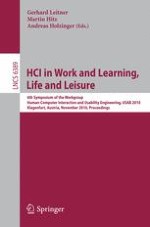2010 | Buch
HCI in Work and Learning, Life and Leisure
6th Symposium of the Workgroup Human-Computer Interaction and Usability Engineering, USAB 2010, Klagenfurt, Austria, November 4-5, 2010. Proceedings
herausgegeben von: Gerhard Leitner, Martin Hitz, Andreas Holzinger
Verlag: Springer Berlin Heidelberg
Buchreihe : Lecture Notes in Computer Science
